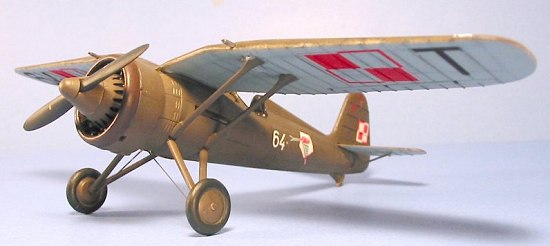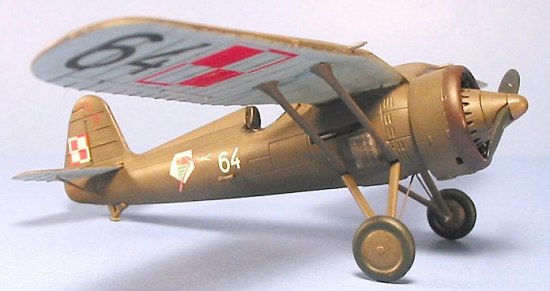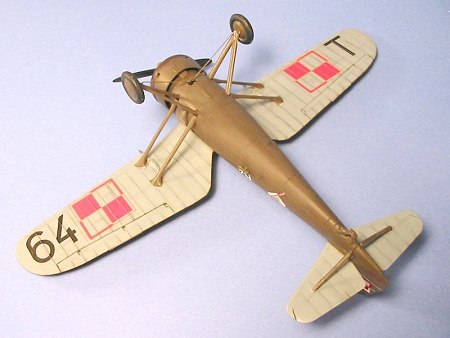
Mirage 1/48 PZL P.11c
|
KIT # |
48101 |
|
PRICE: |
$24.95 |
|
DECALS: |
Four options |
|
REVIEWER: |
Tom Cleaver |
|
NOTES: |

|
HISTORY |
It’s perhaps difficult to believe today, but
between the First and Second World Wars, the newly-reconstituted nation
of Poland had one of the more advanced aviation industries in Europe.
Among the leading lights of the Polish aviation industry was designer
Zygmunt Pulawski, employed at the National Aviation Establishment, or
Panstwowe Zakjady Lotnicze (P.Z.L.). Having spent several years in
France, where he became familiar with the latest aeronautical
developments in Europe’s leading aviation industry, Pulawski designed the
P.1 in 1929 - this parasol fighter was at the time of its first flight,
very likely the most advanced fighter in the world. Its descendant, the
P.11c, would become the primary equipment of the fighter squadrons of the
Polish Air Force. The P.11 had been developed as a result of a
requirement by the Department of Aeronautics of the Ministry for Military
Affairs in 1931 to adapt the then-standard P.7a to use the Bristol
Mercury engine.  Powered by the Mercury V.S2 providing 565 h.p., the
P.11c sub-variant appeared in late 1934. Such was the pace of aircraft
development in the 1930s, this aircraft was already verging on
obsolescence in comparison with the other fighter aircraft that would
make their first flights within a year - the Bf-109, Spitfire and
Hurricane - though its performance was superior to the German Heinkel
He-51 which was beginning to equip the new Luftwaffe, and
certainly the equal of British fighters like the Gloster Gauntlet, or the
Soviet I-15.
Powered by the Mercury V.S2 providing 565 h.p., the
P.11c sub-variant appeared in late 1934. Such was the pace of aircraft
development in the 1930s, this aircraft was already verging on
obsolescence in comparison with the other fighter aircraft that would
make their first flights within a year - the Bf-109, Spitfire and
Hurricane - though its performance was superior to the German Heinkel
He-51 which was beginning to equip the new Luftwaffe, and
certainly the equal of British fighters like the Gloster Gauntlet, or the
Soviet I-15.
Unfortunately, by the time the Second World War broke out, the P.11c was thoroughly outclassed by the Bf-109E, and was barely fast enough to be able to intercept contemporary German bombers like the He-111P. Despite a manifest inability to compete with their opposition on even terms, the pilots of the P.11c were to acquit themselves with distinction during the few weeks in September it took the Wehrmacht to conquer Poland.
Among the Polish pilots who would oppose the Luftwaffe that September was Stanislaw Skalski. Having completed pilot training in 1938, Skalski had been assigned to the 142nd Fighter Squadron, based in Torun. Taking off at first light on being warned of Luftwaffe aircraft violating the border airspace, Skalski scored his first victory - a Henschel Hs-126 reconnaissance aircraft at 5:32 a.m. If Wladyslaw Gnys had not destroyed two Do-17s at 5:30 a.m. - as some sources claim - but rather at 7:00 a.m. as Gnys himself reported - Skalski would have been credited with the first victory of the Second World War.
 During the next two weeks, Skalski became an
ace by shooting down an additional five German aircraft: one Ju-86, two
Do-17s, one Ju-87, and one more Hs-126, plus a third Hs-126 shared with
another pilot. Skalski flew his last sortie against the Luftwaffe on
September 16, 1939; in company with several other pilots, he flew to
Romania on September 17, in hope of being able to continue the fight.
Interned by the Romanians, Skalski and his fellow pilots eventually
managed to get to France in early 1940, where he flew in the Polish
squadron of the Armee d’ l’Air during the German blitzkrieg of
May-June 1940, finally arriving in England in late June, 1940,
During the next two weeks, Skalski became an
ace by shooting down an additional five German aircraft: one Ju-86, two
Do-17s, one Ju-87, and one more Hs-126, plus a third Hs-126 shared with
another pilot. Skalski flew his last sortie against the Luftwaffe on
September 16, 1939; in company with several other pilots, he flew to
Romania on September 17, in hope of being able to continue the fight.
Interned by the Romanians, Skalski and his fellow pilots eventually
managed to get to France in early 1940, where he flew in the Polish
squadron of the Armee d’ l’Air during the German blitzkrieg of
May-June 1940, finally arriving in England in late June, 1940,
Fighting throughout the rest of the war in England, North Africa, Italy, and continental Europe after the Normandy Invasion, Stanislaw Skalski became the most successful Polish ace of the Second World War, with 22 confirmed victories, 1 probable, and 1 damaged enemy aircraft. He was awarded the British Distinguished Flying Cross three times. Following his return to Poland after the war, he was imprisoned by the Communist regime in 1949 on a charge of espionage for the West. He spent six years in prison, waiting for execution, a "reward" from the communists he shared with many other Polish soldiers returning from the West after carrying the honor of their country through the war. Released from prison in 1956, Stanislaw Skalski is still alive (as of this writing) and living in Poland.
|
THE KIT |
 Mirage Hobby’s P.11c is the first mainstream
injection-molded kit of this famous airplane to appear in 1/48 scale. It
is vastly superior in terms of production quality and detail accuracy
when compared to the limited-run LTD P.11 kit. While not of
Tamiya/Hasegawa quality, it is not particularly difficult to turn into a
good model. Surface detail - particularly the difficult-to-mold Wibault
corrugated wing surfaces - is crisply executed and results in a very good
look when completed. The model was based on measurements taken from the
sole surviving P.11c, which is displayed at the Krackow Museum. There are
decals sufficient to do four different aircraft, including Skalski’s and
that flown by Wladyslaw Gnys. For more on what the kit looks like in the
box, please visit the
preview.
Mirage Hobby’s P.11c is the first mainstream
injection-molded kit of this famous airplane to appear in 1/48 scale. It
is vastly superior in terms of production quality and detail accuracy
when compared to the limited-run LTD P.11 kit. While not of
Tamiya/Hasegawa quality, it is not particularly difficult to turn into a
good model. Surface detail - particularly the difficult-to-mold Wibault
corrugated wing surfaces - is crisply executed and results in a very good
look when completed. The model was based on measurements taken from the
sole surviving P.11c, which is displayed at the Krackow Museum. There are
decals sufficient to do four different aircraft, including Skalski’s and
that flown by Wladyslaw Gnys. For more on what the kit looks like in the
box, please visit the
preview.
|
CONSTRUCTION |
The first thing I did was cut off the main
parts and clean off the bit of flash found on them. I then proceeded to
paint the interior of the fuselage and the cockpit parts per the kit
instructions. The kit includes a photoetch instrument panel and seat
belts. 
Once the cockpit was painted and assembled, I proceeded to assemble the fuselage, and to attach the wings and horizontal stabilizers. The engine was painted and detailed, and inserted in the cowling. I left off the wing bracing struts and landing gear until I had completed painting the model. For a bit more info on construction, please visit this review.
|
COLORS AND MARKINGS |
Painting:
I used Tamiya “Khaki” for the upper camouflage color, and Tamiya “Light Blue” (which is their version of RLM65) for the lower surfaces. Once all was dry, I gave the model a coat of Future.
Decals:
The kit decals are quite thin and went down with no problem under a coat of Micro-Sol, though I needed to re-apply the Micro-Sol a few extra times to get the decals to thoroughly settle into the very fine corrugation of the wing surfaces.
|
FINAL CONSTRUCTION |
 I applied three coats of thinned Dullcote to
the model after washing off dried decal solvent and covering the decals
with a final coat of Future.
I applied three coats of thinned Dullcote to
the model after washing off dried decal solvent and covering the decals
with a final coat of Future.
I then attached the wing struts and the landing gear, which gave no problems. I attached the windshield and the photo-etched ring-and-bead gunsight, and the model was finished.
|
CONCLUSIONS |
The P.Z.L. P.11c is an elegant-looking airplane. Given its historical significance in the development of fighter aircraft and its combat record against the Luftwaffe, it is an airplane thoroughly deserving of a place in any comprehensive model collection. The kit is easy to build out of the box, and the result is very nice indeed.
March 2004
Copyright ModelingMadness.com. All rights reserved. No reproduction in part or in whole without express permission from the editor.
If you would like your product reviewed fairly and quickly, please contact the editor or see other details in the Note to Contributors.